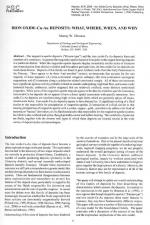Добрый день, Коллеги. Важное сообщение, просьба принять участие. Музей Ферсмана ищет помощь для реставрационных работ в помещении. Подробности по ссылке
Iron oxide-Cu-Au deposits: what, where, when and why
Abstract - The magnetite-apatite deposits ("Kiruna-type") and the iron oxide-Cu-Au deposits form end members of a continuum. In general the magnetite-apatite deposits form prior to the copper-bearing deposits in a particular district. While the magnetite-apatite deposits display remarkably similar styles of alteration and mineralization from district to district and throughout geologic time, the iron oxide-Cu-Au deposits are much more diverse. Deposits of this family are found in post-Archean rocks from the Early Proterozoic to the Pliocene. There appear to be three "end member" tectonic environments that account for the vast majority of these deposits: (A) intra-continental orogenic collapse; (B) intra-continental anorogenic magmatism; and (C) extension along a subduction-related continental margin. All of these environments have significant igneous activity probably related to mantle underplating, high heat flow, and source rocks (subaerial basalts, sediments, and/or magmas) that are relatively oxidized; many districts contain(ed) evaporites. While some of the magnetite-apatite deposits appear to be directly related to specific intrusions, iron oxide-Cu-Au deposits do not appear to have a direct spatial association with specific intrusions. Iron oxide-Cu-Au deposits are localized along high- to low-angle faults which are generally splays off major, crustal-scale faults. Iron oxide-Cu-Au deposits appear to have formed by: 1) significant cooling of a fluid similar to that responsible for precipitation of magnetite-apatite; 2) interaction of a fluid similar to that causing precipitation of magnetite-apatite with a cooler, copper-, gold-, and relatively sulfate-rich fluid of meteoric or "basinal" derivation; or 3) a fluid unrelated to that responsible for the magnetite-apatite systems but which is also oxidized and saline, though probably cooler and sulfate-bearing. The variability of potential ore fluids, together with the diverse rock types in which these deposits are located, results in the wide variety of deposit styles and mineralogies.




